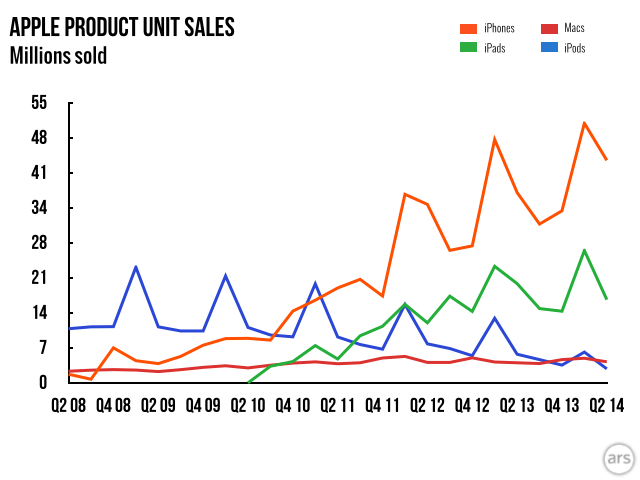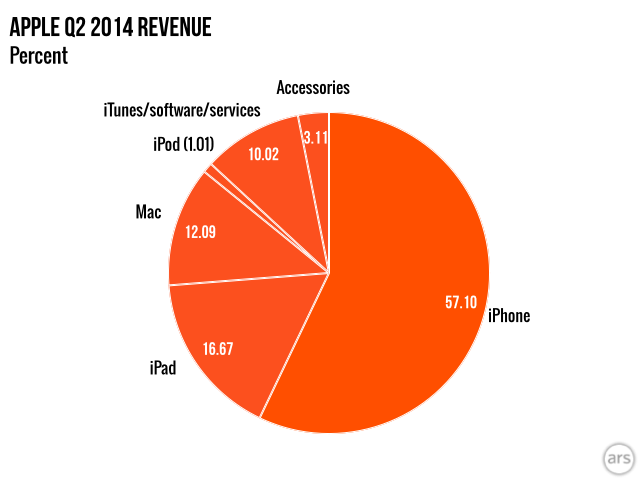The growing maturity of the smartphone and tablet markets was readily apparent in Apple's financial results for the second quarter of its fiscal 2014, which runs from the beginning of January to the end of March. Even though it sold a few more iPhones than it did in the second quarter of 2013, it sold slightly fewer iPads, and both revenues and profit margins were up a little from last year (think single-digit percentage growth).

There's no question that Apple is still making money hand over fist: it reported profits of $10.2 billion on revenue of $45.6 billion, giving it a profit margin of 39.3 percent and beating its own upper guidance of $44 billion from last quarter—those margins also beat the company's upper guidance of 38 percent. It's just that the company is no longer growing as explosively as it once was, something that investors and analysts alike are quick to lose their heads over. Apple's guidance for next quarter predicts revenues between $36 and $38 billion and a profit margin between 37 and 38 percent.
Apple's past growth has been driven mostly by entering entirely new product categories, like it did when it introduced the iPod in 2001, the iPhone in 2007, and the iPad in 2010. The most persistent rumors involve TV (whether a new Apple TV set-top box or an entire television set) and wearable computing devices (the perennially imminent "iWatch"), but calls for larger and cheaper iPhones also continue. An internal Apple presentation shown as part of the ongoing Apple v. Samsung case suggested that most of the continued growth in the smartphone market is coming from phones with larger screens and phones that cost less than $300, though Apple's Phil Schiller noted that the presentation "didn't represent Apple policy."


Update: CEO Tim Cook blamed the size of the decrease on the size of Apple's channel inventory—there was apparently a surplus of iPad minis in the channel last year, whereas this year supply is closer to demand. Soon-to-be-CFO Luca Maestri said that the decline in sell-through to customers was closer to three percent, rather than the 16 percent listed in the results. It's still a drop, but it's a smaller drop, and Cook said the numbers lined up with internal projections.
Moving on from Apple's biggest cash cows, the Mac and iPod lines continue the same sales trends we've been seeing for the last couple years: Macs were up a little, selling 4.14 million units compared to 3.95 million a year ago. These numbers are especially impressive when considered in the context of the wider PC market, which according to Gartner data shrank 1.7 percent year-over-year. This was the first full quarter of availability for the 2013 Mac Pro, and Apple's supply of the machines still hasn't caught up with demand for them, though they continue to represent just a small slice of the overall Mac pie. iPods were way down at 2.76 million units, compared to 5.63 million a year ago. At this point, the entire iPod lineup is responsible for just 1.01 percent of Apple's revenue.

Apple's next major presentation will be in early June at its Worldwide Developers Conference (WWDC) in San Francisco. Apple usually doesn't make major product introductions as part of its WWDC keynote, but we are likely to see the next versions of iOS and OS X, and Apple has refreshed some of its Macs during the keynote in the past. In both 2012 and 2013, new iPhones in September were followed by new iPads and Macs in October.
Listing image by Andrew Cunningham
reader comments
93